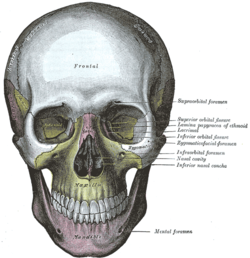Rami mandibulae
| Mandible | |
|---|---|

The mandible
|
|

The human skull, with the mandible shown in purple at the bottom.
|
|
| Details | |
| Precursor | 1st branchial arch |
| Identifiers | |
| Latin | mandibula |
| MeSH | Mandible |
| TA | A02.1.15.001 |
| FMA | 52748 |
|
Anatomical terms of bone
[]
|
|
The mandible, lower jaw or jawbone is the largest, strongest and lowest bone in the human face. It forms the lower jaw and holds the lower teeth in place. The mandible sits beneath the maxilla. The mandible is the only movable bone of the skull besides the ossicles of the middle ear.
The bone is formed from a fusion of left and right processes, and the point where these sides join, the mandibular symphysis, is still visible as a faint ridge in the midline. Like other symphyses in the body, this is a midline articulation where the bones are joined by fibrocartilage, but this articulation fuses together in early childhood.
The word mandible derives from Latin mandibula, "jawbone" - literally, 'one used for chewing', from mandere "to chew" and -bula instrumental suffix.
The mandible consists of:
The body of the mandible is curved somewhat like a horseshoe and has two surfaces and two borders.
From the outside, the mandible is marked in the midline by a faint ridge, indicating the symphysis or line of junction of the two pieces of which the bone is composed at an early period of life. This ridge divides below and encloses a triangular eminence, the mental protuberance, the base of which is depressed in the center but raised on either side to form the mental tubercle. On either side of the symphysis, just below the incisor teeth, is a depression, the incisive fossa, which gives origin to the mentalis and a small portion of the orbicularis oris. Below the second premolar tooth, on either side, midway between the upper and lower borders of the body, is the mental foramen, for the passage of the mental vessels and nerve. Running backward and upward from each mental tubercle is a faint ridge, the oblique line, which is continuous with the anterior border of the ramus; it affords attachment to the depressor labii Inferioris and depressor anguli oris; the platysma is attached below it.
...
Wikipedia
